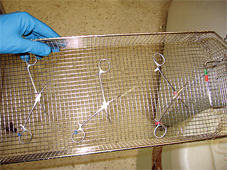 General Principles 1. In general, reusable medical devices or patient-care equipment that enters normally sterile tissue or the vascular system or through which blood flows should be sterilized before each use. The major sterilizing agents used in hospitals are a) moist heat by steam autoclaving, b) ethylene oxide gas, and c) dry heat. 2. Disinfection means the use of a chemical procedure that eliminates virtually all recognized pathogenic microorganisms but not necessarily all microbial forms (e.g., bacterial endospores) on inanimate objects. There are three levels of disinfection: high, intermediate, and low. 3. Heat stable reusable medical devices that enter the blood stream or enter normally sterile tissue should always be reprocessed using heat-based methods of sterilization (e.g., steam autoclave or dry heat oven). 4. Reusable devices or items that touch mucous membranes should, at a minimum, receive high-level disinfection between patients. These devices include reusable flexible endoscopes, endotracheal tubes, anesthesia breathing circuits, and respiratory therapy equipment. 5. Medical devices that require sterilization or disinfection must be thoroughly cleaned to reduce organic material or bioburden before being exposed to the germicide, and the germicide and the device manufacturer's instructions should be closely followed. 6. Except on rare and special instances (as mentioned below), items that do not ordinarily touch the patient or touch only intact skin are not involved in disease transmission, and generally do not necessitate disinfection between uses on different patients.Adidas Crazy 1 ADV
General Principles 1. In general, reusable medical devices or patient-care equipment that enters normally sterile tissue or the vascular system or through which blood flows should be sterilized before each use. The major sterilizing agents used in hospitals are a) moist heat by steam autoclaving, b) ethylene oxide gas, and c) dry heat. 2. Disinfection means the use of a chemical procedure that eliminates virtually all recognized pathogenic microorganisms but not necessarily all microbial forms (e.g., bacterial endospores) on inanimate objects. There are three levels of disinfection: high, intermediate, and low. 3. Heat stable reusable medical devices that enter the blood stream or enter normally sterile tissue should always be reprocessed using heat-based methods of sterilization (e.g., steam autoclave or dry heat oven). 4. Reusable devices or items that touch mucous membranes should, at a minimum, receive high-level disinfection between patients. These devices include reusable flexible endoscopes, endotracheal tubes, anesthesia breathing circuits, and respiratory therapy equipment. 5. Medical devices that require sterilization or disinfection must be thoroughly cleaned to reduce organic material or bioburden before being exposed to the germicide, and the germicide and the device manufacturer's instructions should be closely followed. 6. Except on rare and special instances (as mentioned below), items that do not ordinarily touch the patient or touch only intact skin are not involved in disease transmission, and generally do not necessitate disinfection between uses on different patients.Adidas Crazy 1 ADVSterilization or Disinfection of Medical Devices
Source: Release Date:2009-12-08 312
 General Principles 1. In general, reusable medical devices or patient-care equipment that enters normally sterile tissue or the vascular system or through which blood flows should be sterilized before each use. The major sterilizing agents used in hospitals are a) moist heat by steam autoclaving, b) ethylene oxide gas, and c) dry heat. 2. Disinfection means the use of a chemical procedure that eliminates virtually all recognized pathogenic microorganisms but not necessarily all microbial forms (e.g., bacterial endospores) on inanimate objects. There are three levels of disinfection: high, intermediate, and low. 3. Heat stable reusable medical devices that enter the blood stream or enter normally sterile tissue should always be reprocessed using heat-based methods of sterilization (e.g., steam autoclave or dry heat oven). 4. Reusable devices or items that touch mucous membranes should, at a minimum, receive high-level disinfection between patients. These devices include reusable flexible endoscopes, endotracheal tubes, anesthesia breathing circuits, and respiratory therapy equipment. 5. Medical devices that require sterilization or disinfection must be thoroughly cleaned to reduce organic material or bioburden before being exposed to the germicide, and the germicide and the device manufacturer's instructions should be closely followed. 6. Except on rare and special instances (as mentioned below), items that do not ordinarily touch the patient or touch only intact skin are not involved in disease transmission, and generally do not necessitate disinfection between uses on different patients.Adidas Crazy 1 ADV
General Principles 1. In general, reusable medical devices or patient-care equipment that enters normally sterile tissue or the vascular system or through which blood flows should be sterilized before each use. The major sterilizing agents used in hospitals are a) moist heat by steam autoclaving, b) ethylene oxide gas, and c) dry heat. 2. Disinfection means the use of a chemical procedure that eliminates virtually all recognized pathogenic microorganisms but not necessarily all microbial forms (e.g., bacterial endospores) on inanimate objects. There are three levels of disinfection: high, intermediate, and low. 3. Heat stable reusable medical devices that enter the blood stream or enter normally sterile tissue should always be reprocessed using heat-based methods of sterilization (e.g., steam autoclave or dry heat oven). 4. Reusable devices or items that touch mucous membranes should, at a minimum, receive high-level disinfection between patients. These devices include reusable flexible endoscopes, endotracheal tubes, anesthesia breathing circuits, and respiratory therapy equipment. 5. Medical devices that require sterilization or disinfection must be thoroughly cleaned to reduce organic material or bioburden before being exposed to the germicide, and the germicide and the device manufacturer's instructions should be closely followed. 6. Except on rare and special instances (as mentioned below), items that do not ordinarily touch the patient or touch only intact skin are not involved in disease transmission, and generally do not necessitate disinfection between uses on different patients.Adidas Crazy 1 ADV
You May Like

 iConnectHub
iConnectHub
 Login/Register
Login/Register Supplier Login
Supplier Login


























